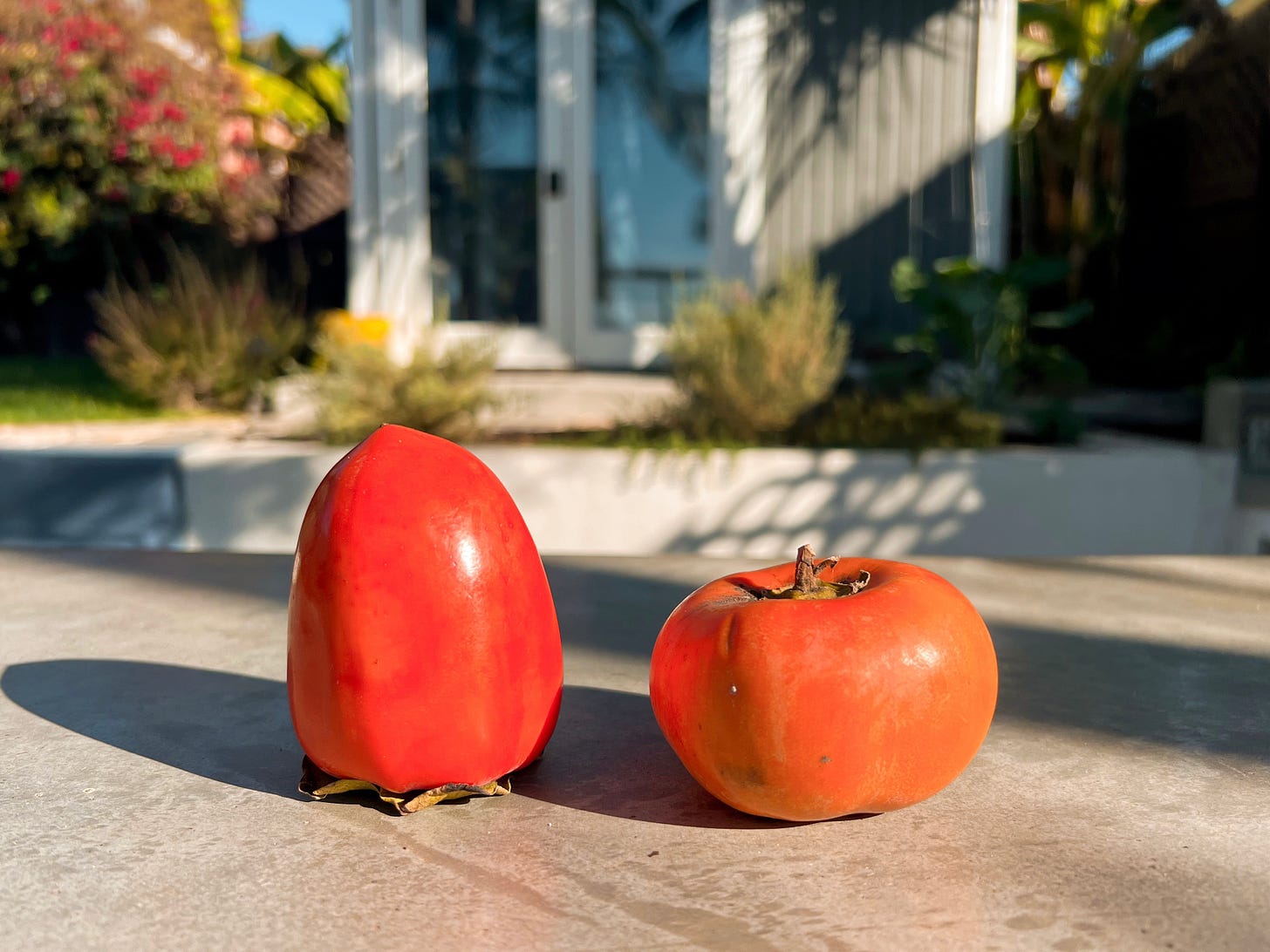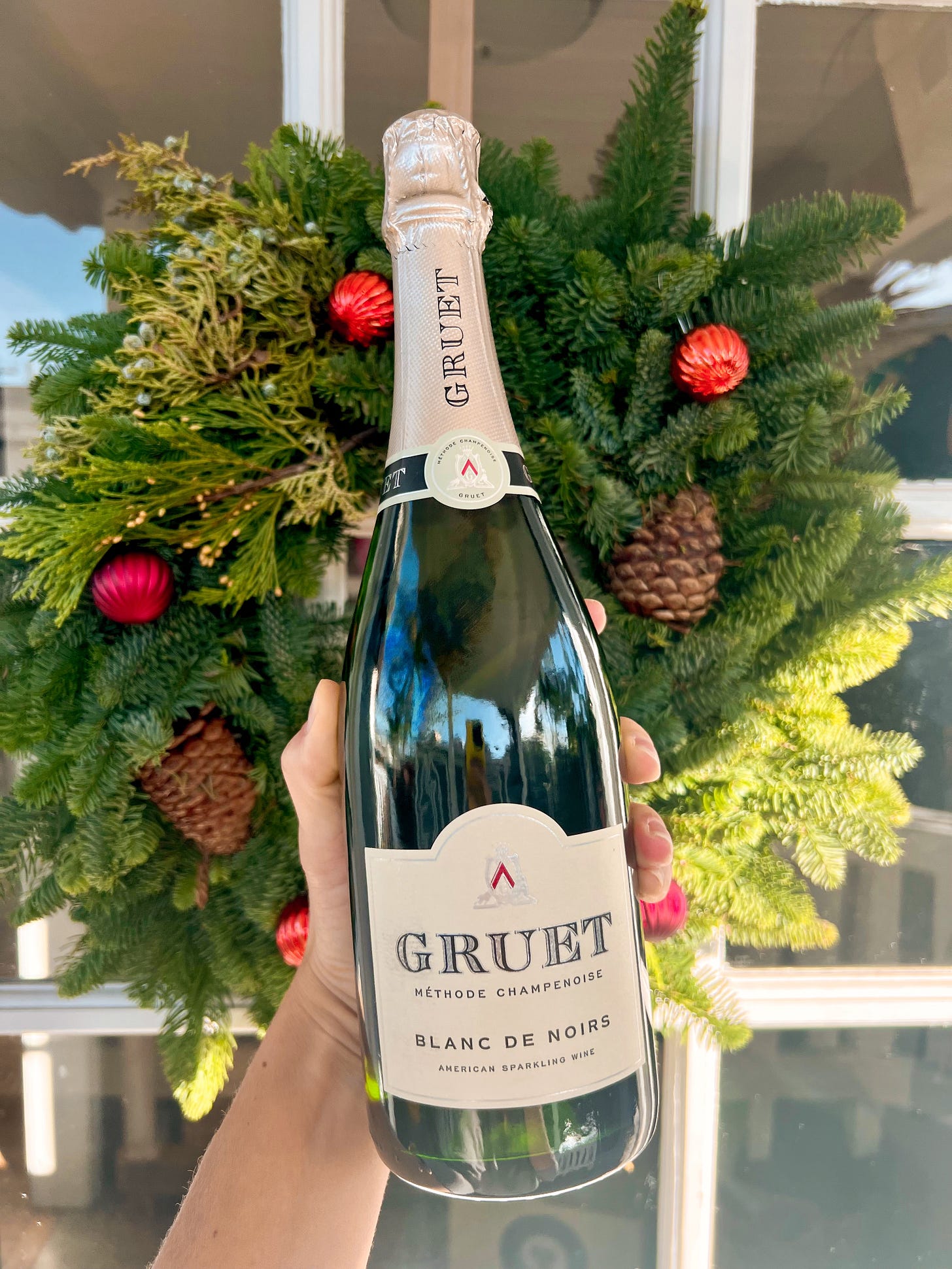Thank you so much for reading Californiavore. If you are enjoying what you are reading, please consider sharing with a friend who might also like a dose of California sunshine. And if you haven’t already, please subscribe (it’s free!) so you never miss a recipe, story, or wine recommendation.
In the yard of a modest house at the end of a modest street in an otherwise forgettable town, there was a magic garden. At least it was magic in the mind of my childhood self. The garden belonged to my paternal grandparents. They moved to the town, the place where I was born and raised, because of the golf. Golf, you see, benefits from sunny days and warm weather. Hemet was cheaper to live in than Palm Springs and its endless golf courses, just east over the San Jacinto mountains. The weather was a bit cooler on our side of the range, but we basked in about the same number of days of sun. Ideal conditions for golf and growing things – sometimes exotic things, magic things, like persimmons.
My grandfather was an admirable gardener. If his garden excelled in a particular season, fall was its fullest self. A giant black walnut tree shaded half the yard, dropping sticky pods that we would pry open in search of sweet nut meat. The pomegranate tree grew a prodigious amount of fruit. When we’d gathered enough, we would spend a day with my grandfather knocking jewel-like seeds out of pods that he would stir in giant pot, until scalding and syrupy, destined for jam jars.
Perhaps the most mystical of fruits to me was the persimmon. This was not a time when one found persimmons in the grocery store, as you might now. Smooth skin the color of a sunset, they grew squat and round or larger and heart shaped, depending on the tree. Bite into one too early, and you would regret it. Wait a few days and this fruit would transform into something luscious, like jelly right out of the skin.
There are hundreds of varieties of persimmon. An indigenous variety can be found on the East Coast of the United States, producing small, astringent fruit that is only pleasant to eat when fully ripe. Most of what we find in the California today are two Asian cultivars, the Fuyu and the Hachiya. Fuyus have firm flesh and can be eaten as soon as they come to full color, with or without skin depending on your taste for it. These are great in salads or can be added to an upside-down cake along with pears and apples for an attractive combination of fall fruits.
Hachiya, the heart shaped variety, can only be eaten when fully ripe. Buy them hard from the market, then let them sit out for a week or two until they feel like loosely filled water balloons.
My grandmother would use the pulp of this variety to make a tender, cake-like cookie, seasoned with cinnamon and clove. The fruit has a natural spiciness that lends itself well to some of the same flavors you might use for other fall favorites, like pumpkin and apple.
These days it is rather easy to find persimmons, popping up in the farmer’s market and grocery store from late fall through early winter. After buying a basket a week back, I was in the mood for something like my grandmother would make, but that could straddle the line between breakfast and dessert. A quick bread with a persimmon infused glaze could make for an indulgent morning treat or a simple dessert, gussied up with a dollop of whipped cream and maybe some diced Fuyu persimmons for good measure. Baked in a mini loaf tin, it is an easy gift to take along when meeting a friend for coffee. And what is a homemade treat but a little bit of magic for grown ups?
Recipe
Persimmon Mini Loaves
This recipe is for mini loaves as I like the ease of gifting an extra one to a neighbor or friend, especially this time of year. However, feel free to make in a full-size loaf pan, just increase the cooking time by 10 – 15 minutes.
1 cup whole wheat pastry flour
1 cup all-purpose flour
1 tsp. baking powder
1 tsp. baking soda
1 tsp. ground cinnamon
½ tsp salt
¼ tsp. ground nutmeg
¼ tsp. ground cardamon
1 ¼ cup persimmon pulp from 4 ripe Hachiya persimmons
2 eggs, lightly beaten
½ cup vegetable oil
½ cup packed light brown sugar
¼ cup white sugar
¾ cup walnuts, roughly chopped
Glaze
1 cup confectioner’s sugar, sifted
1 T. lemon juice
Preheat oven to 350°F. Grease four mini loaf pans (or one regular bread loaf pan).
In a medium bowl whisk together flours, baking powder, baking soda, spices, and salt.
In a large bowl, whisk 1 cup of the persimmon pulp, with eggs, oil, and sugars. Fold in flour mixture and ½ cup of chopped walnuts.
Divide mixture evenly between the four tins. Place in oven and bake for 30 – 35 minutes (45 minutes for a full loaf tin). Test for doneness with a toothpick or wooden skewer. It will be done when no wet batter clings to the skewer.
While loaves are baking, make the glaze. Press remaining persimmon pulp through a sieve into a small bowl, discarding any solids. Add confectioner’s sugar to persimmon pulp along with lemon juice. Whisk until smooth.
Let loaves cool for 10 minutes until they can easy be popped from the pans. Place on a piece of parchment paper and drizzle glaze evenly over each loaf letting dribble down the sides. Top with remaining walnut pieces.
To Drink…
Gruet Blanc de Noirs, United States, NV
While this isn’t exactly a pairing, there is a never a bad time for bubbles. And if there is ever a good time, now is it. If you’ve recently found yourself at Total Wine or Costco with your eyes crossed in front of boxes of sparkling wine, not sure how to tell a decent cava from a too-sweet Prosecco, allow me to direct your gaze a different direction, to the domestic shelf. There, somewhere south of Schramsberg and north of Korbel (I’m sure you’ve noticed how the most expensive wine is usually on eye level and you are forced to couch down in a frog squat for the values) is a sparkling wine from New Mexico that should be in your fridge all year long. Yes, you read that right, New Mexico.
Launched nearly 40 years ago near the town of Engle, Gruet was the dream of Gilbert Gruet, a vigneron from Bethon in the Champagne region of France. After traveling with his family on vacation, Gilbert met fellow Europeans making still wines from grapes grown in the high-altitude soils of the Southwest. He immediately saw potential for growing Pinot Noir and Chardonnay and making sparkling wine in the champagne method for an American audience.
In 2011, Gruet’s Blanc de Noir, a white sparkler made with Pinot Noir grapes, won a spot on Wine Spectator’s Top 100 Wines list. Wine Spectator called this wine “Elegant and focused, with creamy vanilla and apple aromas and rich yet crisp flavors of baked pear and cinnamon bread.” Maybe a perfect pairing for Persimmon Loaves after all.
From $14.49 at Total Wine and others.








Straddling breakfast & dessert 🙌